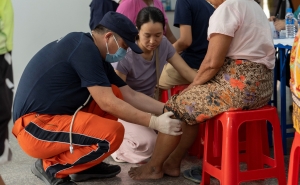Policies That Reduce Gun Violence: Extreme Risk Protection Orders

A targeted legal tool for intervening before tragedies happen.
In 1999, in response to a mass shooting at the state’s lottery headquarters, Connecticut passed the nation’s first law authorizing the removal of firearms from people believed to pose a significant risk to themselves or others. Indiana followed in 2005.
In 2013, the Consortium for Risk-Based Firearm Policy released a set of recommendations, including that states pass ERPO laws that expand on the CT and IN laws by incorporating evidence from domestic violence protection orders. Today, 19 states and Washington, DC, have such laws. The laws vary in name and detail, but they have a common purpose: temporarily restricting access to guns by people who are behaving dangerously and present a risk of harming themselves or others.
In this Q&A, firearm policy experts Shannon Frattaroli, PhD, MPH, and Jeffrey Swanson, PhD, explain how ERPOs work and why they’re a powerful tool to prevent gun violence and save lives.
This Q&A is adapted, with updates, from Frattaroli and Swanson’s presentation at Policies that Work to Reduce Gun Violence, a September 2019 forum highlighting science and policy solutions to the nation’s epidemic of gun violence.
What exactly is an extreme risk protection order?
An extreme risk protection order, or ERPO, is an order from a judge that authorizes law enforcement officers to temporarily remove firearms from a person (the “respondent”) who is behaving dangerously and poses a high risk of harming themselves or someone else. ERPOs also temporarily prohibit respondents from purchasing new guns for the duration of the order.
It is important to note that these laws are focused on intervening when people are behaving dangerously and making threats about what they’re likely to do. This is a behavior-oriented intervention.
ERPOs are temporary (up to a year in most states) and do not result in a criminal record for the respondent.
Why are they needed?
Many people who pose a high risk of harming themselves or someone else with a firearm can legally possess guns and would pass a background check at the point of sale.
Without an ERPO law, states don’t have a legal mechanism to intervene and restrict access to guns, even when a person exhibits behavior showing he or she is at risk of committing violence, whether suicide or homicide. ERPO laws provide a legal means, through civil courts with due process protections, to do so.
Who can initiate an ERPO?
In all states, law enforcement can initiate ERPOs. Most states also allow family members and intimate partners to petition for ERPOs. In a few states, different combinations of health professionals, school administrators, employers, and coworkers may request that a court grant an ERPO when someone is behaving dangerously and is at risk of harming themselves or others. In most states, law enforcement initiates the large majority of ERPOs.
How does the process work?
The process is set in motion when a concerned person petitions the court by completing a form (typically available on courts’ websites) detailing the respondent’s dangerous behaviors and submitting it to the courthouse. (See individual state requirements.)
Most states have a two-stage process. The first stage allows for short-term firearm removal through a hearing at which the respondent is not present (an ex parte hearing). If the temporary ERPO is granted, police remove the respondent’s guns, and the national background check system is updated to bar gun purchases while the order is in effect.
The second stage is a hearing (a couple of days or weeks after the temporary order is granted, depending on the state) with both the respondent and petitioner, during which the court decides whether to extend the ERPO and for how long. Most states allow for these second-stage orders to extend for up to one year.
When deciding whether to issue or extend an ERPO, courts consider dangerous behaviors, such as suicide threats or threats or acts of violence, and whether the risk is imminent.
Do ERPOs save lives?
While more research is needed, early research is promising. Studies in Connecticut and Indiana (the states with the first ERPO laws) have shown that for every 10–20 risk-based gun removal actions, one life was saved through averted suicide. In Connecticut, ERPOs provided a portal to treatment for about a third of respondents. And a review of ERPO cases in California and King County, Washington, shows that ERPOs have been issued when people are planning mass shootings.
In states where these laws are in place, it is critical to ensure that this important policy is known and used so violence can be stopped before it happens. The Bloomberg American Health Initiative’s ImplementERPO website is designed to help law enforcement, families, and clinicians make the most of the ERPO laws in their communities.
Shannon Frattaroli, PhD ’99, MPH ’94, is an associate professor in Health Policy and Management and a core faculty member of the Johns Hopkins Center for Gun Violence Prevention and Policy at the Johns Hopkins Bloomberg School of Public Health.
Jeffrey Swanson, PhD, MA, is a professor in Psychiatry & Behavioral Sciences at Duke University School of Medicine.
Related Content
- “Red Flag” Laws: Extreme Risk Protection Orders and What Went Wrong in Indiana (podcast)
- Extreme Risk Protection Order: A Tool to Save Lives
- ERPO: A Civil Approach to Gun Violence Prevention Teach-Out (Coursera)
- Dismantling the Narrative





